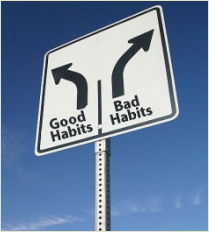How to Change Bad Habits: Two Methods to Choose From
 In a world of 20-second commercials that promise instant solutions, tochange bad habits seems possible in just a snap, right?
In a world of 20-second commercials that promise instant solutions, tochange bad habits seems possible in just a snap, right?
Bald hype.
When it comes to changing bad habits, don’t be surprised if easy, super-quick solutions don’t work. You’re smarter than that! You realize that lasting change of bad habits requires adjusting your lifestyle, and that simply can’t happen overnight. Yes, the information you need to change bad habits it’s all here, but it won’t work just by itself. You actually have to apply it in your own life!
You already know that bad habits damage your self esteem.
Also, to shape your own destiny and lead a life of abundance and prosperity, your behavior must be aligned with your goals. If it is not, then it’s necessary to change bad habits.
But before being able to break a bad habit, you have to first identify what it is. For example, if you tend to wait until the stress of the last minute to take action, procrastination is an example of a bad habit.
There are thousands of studies and articles on procrastination.
Napoleon Hill, the founder of personal success movement said,“Procrastination is the bad habit of putting off until the day after tomorrow what should have been done the day before yesterday”.
Think about it. Is procrastination one of the habits of successful people?
Sure, in a stressful and hectic world, there are always reasons: not enough time, something else is more pressing, you’re too tired, and so on. But regardless of the perceived causes of procrastination, when you get down to it you easily realize that it not only hurts you; it also hurts the trust of people close to you, who rely on you.
The effects of procrastination include the high stress of dealing with tight deadlines, inefficiencies at work and misunderstandings at home. Procrastination is nothing else than giving away self responsibility, so overcoming procrastination means changing a bad habit.
But how exactly do you do this?
Well, there are two ways; a hard way and an easy way. Let’s take a quick look at both of them, so you can choose which one you want to use.
Change Bad Habits with Alternate, Better Habits
One common idea in the personal development field is that once you find a more empowering alternative to your bad habit and practice it for 21-30 days repeatedly, you hardwire the new habit into your brain. This change happens one day at a time, and it begins when you decide to start focusing on a better habit, in the present, rather than the old one, in the past.
For example, breaking your tasks into small, manageable steps is an alternate habit that helps you overcome procrastination. Another one is to use time management tools, creating a list of To Do items and ticking off the completed ones to give yourself a sense of accomplishment as a positive reinforcement.
But you must understand this.
You need a huge amount of self-motivation and discipline to use the new, alternate habit consistently until the positive change you want it’s going to be fully integrated in your life. Then, you must watch for relapses and reinforce the new behavior with various reminders like affirmations for success - little bits of positive self-talk to maintain the positive change in your life.
However, you may have heard that change (of any kind) threatens your sense of security. When you’re used to doing something in a certain way, the thought of changing it makes your subconscious to panic and keep you stuck where you are, regardless of how beneficial this change would be. Agonizing, isn’t it?
So what else can you do?
Change Bad Habits by Addressing the Core Issue
Believe it or not, a bad habit is a behavioral pattern acquired at some point in your life due to an unaddressed emotional issue. You wouldn’t do something repeatedly unless the bad habit is working for you – at some level.
For example, if you smoke, you may release emotional stress. If you overeat consistently, you may be “stuffing down” the emotional pain of anger or of feeling lonely. If you’re biting your fingernails or tapping your foot, you may be relieving anxiety.
Once acquired, it’s almost impossible to get rid of a bad habit by sheer will power. Your bad habit is meeting a need; figure out what that need is and you’re a step closer to breaking your bad habit.
When you fully understand what you’re getting out of a bad habit, you can choose to address this core issue by dealing with the underlying emotional distress causing it. Believe it or not, just allowing yourself to feel this emotion fully is a great help in making it lose its power over you.
Recently, cutting-edge self help resources helping you to change bad habits are increasingly popular due to their huge effectiveness: self hypnosis scripts or self hypnosis mp3s that use subliminal messaging, NLP(Neuro-Linguistic Programming), Sedona Method, and EFT (Emotional Freedom Technique) are just a few.
Either method you choose, to change bad habits requires emotional intelligence and mindfulness: being fully aware of what you are doing in the moment. It also requires a commitment to want to improve your life. Yes, it is your life we are talking about, don’t you think it’s worth it?



